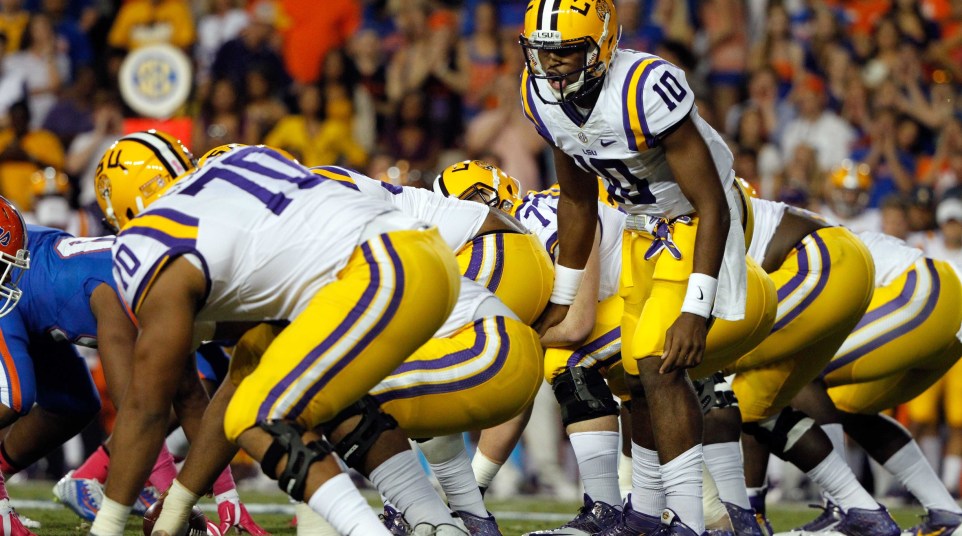LSU's passing offense: Les Miles' worst?
LSU’s 2014 season has been one of the more interesting seasons in recent memory for the Tigers. It’s been an up-and-down campaign, with blowout wins and losses, failed comebacks and gutsy wins. One thing has been consistent throughout: the Tigers stink when it comes to passing the ball.
There have been some moments when LSU has looked competent and even potent through the air. Brandon Harris put up some impressive numbers in an abbreviated stint against Mississippi State, and was nearly as good the following week in relief against New Mexico State. For the most part, though, that hasn’t been the case.
In six of 10 games so far this season, though, LSU completed 50 percent or fewer of its passes, adding up to a pathetic 48.9 completion rate for the year. That would rate as by far the worst passing season of Les Miles’ 10 years in Baton Rouge.
| Comp. % | Yards | TD | INT | YPG | YPA | |
|---|---|---|---|---|---|---|
| 2005 | 60 | 2912 | 22 | 10 | 224 | 8.1 |
| 2006 | 66.5 | 3272 | 30 | 9 | 251.7 | 8.9 |
| 2007 | 57.9 | 3154 | 29 | 13 | 225.3 | 7.1 |
| 2008 | 52.7 | 2617 | 21 | 18 | 201.3 | 6.7 |
| 2009 | 58.9 | 2363 | 19 | 8 | 181.8 | 7 |
| 2010 | 57.5 | 2023 | 10 | 11 | 155.6 | 6.7 |
| 2011 | 62 | 2135 | 21 | 5 | 152.5 | 7.7 |
| 2012 | 58.4 | 2607 | 12 | 7 | 200.5 | 7.4 |
| 2013 | 62.9 | 3263 | 23 | 9 | 251 | 10 |
| 2014 | 48.9 | 1773 | 15 | 8 | 177.3 | 8.1 |
This season is on pace to be the worst season of Miles’ tenure in terms of completion percentage, and with the team on pace to throw for 2,069 yards in the regular season it’ll likely edge out 2010, and possibly 2011, in terms of passing yardage. The offense looks better than it actually is, thanks to nearly 16 percent of the Tigers’ completions going for 30 or more yards. That big-play ability has kept the passing game afloat, but it hasn’t generated any consistency through the air.
The 2010 and 2011 seasons were definitely rough from a passing standpoint, with Miles flipping between Jarrett Lee and Jordan Jefferson for the two campaigns. Even when LSU made it to the 2011 national championship game, Miles was still rotating his quarterbacks. The 4.25:1 touchdown-to-interception ratio helped make 2011 the rosier of the two seasons, as does the 62 percent completion rate.
In 2010, LSU threw more interceptions (11) than touchdowns (10). Jefferson was the main triggerman, completing 56.5 percent of his passes at a paltry 6.8 yards per attempt. He threw 10 INTs against 7 TDs, infuriating fans with his inability to read coverages and a propensity for taking bad sacks. Some fans clamored for Lee, although he proved to be just an inept in most of his time in an LSU uniform.
Jennings is not quite as pull-your-hair-out frustrating at the 2010-11 quarterbacks. He doesn’t generally make bad decisions, rather just bad throws that lead to interceptions. Even so, he’s only thrown 6 interceptions in his playing time this year. The problem is those bad throws. Jennings will often miss open receivers, both with the throws he makes and the ones he doesn’t. Miles, just as he did with Jefferson and Lee, says that Jennings is improving when it comes to making the right decisions.
The quarterback himself told Ross Dellenger of The Advocate (Baton Rouge) that he’s busting it in the film room, even breaking himself down right after games, but the results haven’t shown. Jennings’ completion percentage hasn’t been above 50 percent in a single game since mid-September, and he hit a nadir with a 30.8 completion percentage against Alabama. A lot of those incompletions — at least six of the 14 — came on drops. If Jennings had been at the 50 percent mark he’d been hitting so often, LSU might have pulled out a win over Alabama.
Like in 2010 and 2011, LSU is leaning heavily on its running game. This season, they’re running it 69 percent of the time on offense at 4.5 yards per carry. In 2010 it was 64 percent, again at 4.5 yards per carry, and 68 percent and 4.8 yards per carry in 2011.
While LSU is less consistent completing passes this year than it was in 2010, the Tigers are doing more with what they do complete than most teams in college football, as well as making fewer mistakes. While 2014 certainly hasn’t been a banner year for throwing the ball in Baton Rouge, especially coming off a spectacular year passing in 2013, it’s still not the worst.

